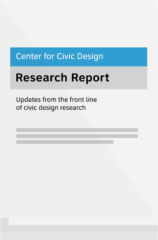Return ballot design analysis from Washington
What are the design elements that make a ballot most likely to be rejected? In September 2023, we conducted an analysis of 15 return envelopes with the lowest challenge rates in Washington to find out if there are any commonalities to the layouts with the fewest rejections. Through these case studies, we identified principles for good design, including how a clear layout helps voters scan information easily and that when information is in the right place, voters read it “just in time”.

Return ballot design analysis from Washington
This research was part of a larger study by the Evans Policy Innovation Collaborative (EPIC): Understanding Patterns and Trends in Rejected Mailed Ballots in Washington State. Download the full report.
Key findings
We’ve gathered 5 principles from our research to improve the design of return envelopes in Washington and reduce the number of envelopes rejected.
Fewer words make the text easier to understand
Why is this principle important? Plain language makes text easier to read. Fewer words also allow for more white space around each block of text, so each element on the envelope stands out. This applies especially to the declaration.
Use visual cues to draw attention to important information
Text size, bolding and visual elements (like icons and boxes) are effective ways to highlight the most important elements of an envelope.
Why is this principle important? When voters don’t see important information or areas to sign and date the envelope, their ballot might not be counted. This is especially when voters miss the signature area and their ballot is rejected.
Create space between sections
Why is this principle important? White space is a buffer between each element on the envelope, helping voters see everything clearly.
Create a clear layout with a grid or column margins to align elements on the envelope
Why is this principle important? Combined with space between sections, organizing information with a clear flow helps voters scan the information easily.
Put information where voters will find it
Why is this principle important? When information is in the right place, voters read it “just in time.” This applies especially to the reminder to sign and date the envelope and return deadlines.
About the research
This research was conducted by Fernando Sánchez and Whitney Quesenbery.
The 15 counties we analyzed were: Franklin, Ferry, Clallam, Greys Harbor, Pacific, Whatcom, Chelan, Pend Oreille, Pierce, Skagit, Cowlitz, Thurston, Island, Asotin, and Klickitat.
Our approach involved categorizing layout structures and analyzing the following sections within each envelope:
- Declarations
- Signature
- Witness
- Postmark and signature reminders
- County information
Related resources
Our field guide, Vol. 104 Designing vote by mail envelopes, includes envelope templates that are ready to download and free to use.
Visit our page on ballot design for tools, research and guides on the topic.

